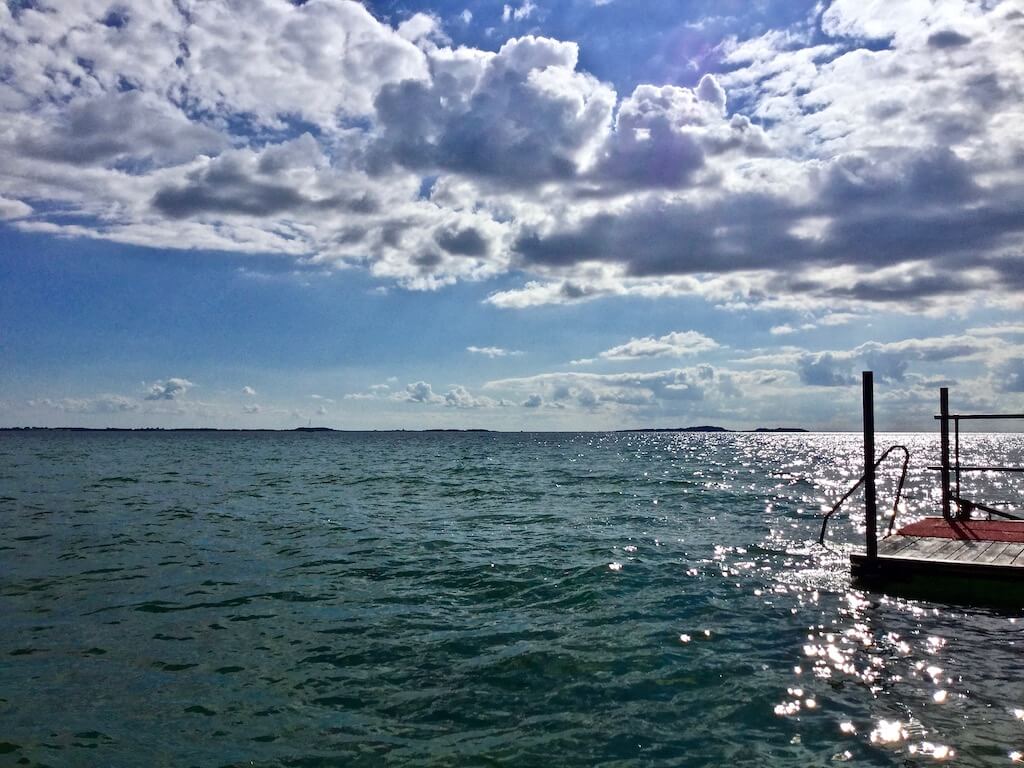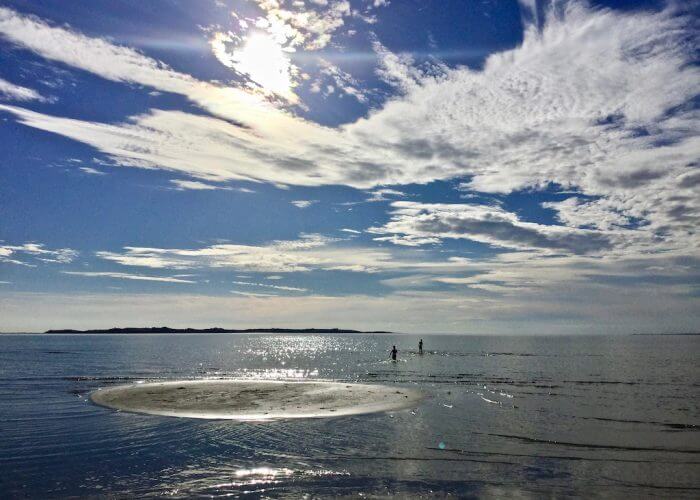Potential Risks Of COVID-19 For Open Water Swimmers Highlighted By UNC Research Paper

A 2009 research paper from the University of North Carolina at Chapel Hill published by Science Direct provides insight to the potential risks to open water swimmers and reasons why the sport’s authorities need to seek expert guidance if they wish to ensure that athletes return to safe waters when the coronavirus COVID-19 lockdowns draw to an end.
The research includes observations in “natural environmental waters”, while the study’s conclusions highlight potential risks of COVID-19 for open water swimmers and raise questions for the sport in general.
In relation to the 2003 outbreak of coronavirus SARS-CoV, the paper states: “The persistence of coronaviruses in water observed in this study suggests that if SARS-CoV should reemerge in human populations, water contaminated with these viruses may continue to pose an exposure risk even after infected individuals are no longer present.”
As swimmer’s dream of water and talk turns to exit strategies from the coronavirus pandemic beyond what experts and politicians are acknowledging may be several more weeks of lockdowns, updates on the safety of swimming in treated water stand in stark contrast to the lack of clarity on open water.
The Centers For Disease Control and Prevention last week added information to its advice on the spread of COVID-19 virus in spas and water playgrounds:
“There is no evidence that COVID-19 can be spread to humans through the use of pools, hot tubs or spas, or water playgrounds. Proper operation, maintenance, and disinfection (e.g., with chlorine and bromine) of pools, hot tubs or spas, and water playgrounds should inactivate the virus that causes COVID-19.
“While there is ongoing community spread of COVID-19, there should be appropriate care taken both in and outside the pool, to protect yourself and others. Owners and operators of community pools, hot tubs, or spas should follow the interim guidance for businesses and employers to plan and respond to COVID-19.”
That guidance includes an answer to the question: “Is the COVID-19 virus found in feces?” The answer:
“The virus that causes COVID-19 has been detected in the feces of some patients diagnosed with COVID-19. The amount of virus released from the body (shed) in stool, how long the virus is shed, and whether the virus in stool is infectious are not known.
“The risk of transmission of the virus that causes COVID-19 from the feces of an infected person is also unknown. However, the risk is expected to be low based on data from previous outbreaks of related coronaviruses, such as severe acute respiratory syndrome (SARS) and Middle East respiratory syndrome (MERS). There has been no confirmed fecal-oral transmission of COVID-19 to date.”
Questions raise for Swimming In Further 2009 Research

Photo Courtesy: Craig Lord
The ‘unknowns’ are specific to COVID-19. More has been known about the relationship between coronavirus, water and the risks of any presence of fecal material, for many years. After Swimming World highlighted a 2008 University of Arizona research into the relationship between water and coronavirus, another key study from an American university has come to light.
ScienceDirect’s archive includes a six-page entry in the Water Research publication published this week 11 years ago in April 2009 headlined “Survival of surrogate coronaviruses in water”
- The paper is written by University of North Carolina researchers Lisa Casanova, of the Department of Environmental Sciences and Engineering, William A. Rutala and David J.Weber, of the Department of Medicine, and Mark D. Sobseya.
It’s key conclusions hint at why it may be significant to swimming authorities wishing to ensure that swimmers return not a safe environment come the hour.
The paper’s key conclusions include:
- “The coronaviruses TGEV and MHV survived and remained infectious for long periods in different water types.”
- “Both viruses survived and remained infectious at both low (4 °C) and ambient (25 °C) temperatures.”
- “The persistence of coronaviruses in water observed in this study suggests that if SARS-CoV should reemerge in human populations, water contaminated with these viruses may continue to pose an exposure risk even after infected individuals are no longer present.”
The authors also note the following on the SARS-CoV virus outbreak of 2003: “If water or sewage contaminated with SARS-CoV becomes aerosolized, it could potentially expose large numbers of people to infection. This could create an ongoing risk during an outbreak, even with quarantine measures to isolate infected individuals.”
While most adequately treated waters are safe (in themselves as opposed to the obvious risks of close human contact in a pool environment, including changing rooms and showers), the authors, looking at an ocean of issues beyond the realm of sport, point to issues of concern to open water swimmers. In conclusions, the study notes:
“The coronaviruses studied were capable of remaining infectious in reagent-grade waters, natural environmental waters, and waters contaminated with human fecal waste (sewage) for periods of weeks. This long-term survival was seen at both low (4 °C) and ambient (25 °C) temperatures. In all water types, the titer of infectious virus declined more rapidly at 25 °C than at 4 °C. Infectivity titer reductions over about 6 weeks ranged from none, to slight (<1 log10) to modest (1–2 log10) at 4 °C, depending on water quality and virus type. Virus inactivation was more rapid in settled sewage than reagent-grade water.”
The range of temperatures suggested coincides with the range in which many open waters swimmers train and compete. Their work points to a depth of research on viral survival in water dating back to the 1970s.
Relevant to swimmers is an environment in which swimmers breathe in aerosolised water, which can aid transmission of viruses. The authors note the dangers in specific reference to respiratory pathogens, including Legionella, and in situations where the presence of urine and fecal matter can increase risks of transmission:
“It has been established with other human pathogens that formation of droplets and aerosols from water contaminated with microorganisms can serve as a vehicle for transmission. Examples include Legionella, a respiratory pathogen acquired when contaminated water droplets are inhaled (Butler and Breiman, 1998), and Cryptosporidium, an enteric pathogen acquired via ingestion of contaminated droplets (CDC, 1998). Desiccation and aerosolization of body fluids and fecal matter, resulting in ingestion or inhalation of dried particles, can also serve as a source of pathogens such as norovirus (Marks et al., 2003) and hantavirus (LeDuc, 1998). SARS was spread when water contaminated with fecally shed virus was inhaled, causing respiratory infection.
“This person-to-person fecal droplet–respiratory transmission route was observed in the Amoy Gardens apartment building outbreak in Hong Kong, the largest point-source outbreak attributable to this type of transmission pathway. When an individual shedding infectious virus in feces used the toilet facilities in a building, a combination of faulty drain traps and powerful exhaust fans in residential units resulted in virus-laden liquid droplets being drawn from the waste system into living spaces via floor drains. The droplets were inhaled by occupants and carried on air currents to other areas of the building, resulting in a large number of SARS cases (WHO, 2003, McKinney et al., 2006). More data are needed on the survival of SARS-CoV in fecal droplets and aerosols to assess this new risk pathway in the event that SARS reemerges. The results of this study suggest that coronaviruses can survive long enough in water and sewage for these vehicles to serve as a source of exposure. The potential for long-term survival, along with the airborne fecal droplet transmission model, suggests that fecally contaminated aqueous media could pose a health risk in future outbreaks.”
Heightened Sensitivity In A Sport That Has Known The Ultimate Tragedy

Fran Crippen – Never Again … a 2015 Swimming World cover … and since then, races under FINA rules have been held in waters over the 31C limit – Photo Courtesy: Swimming World Magazine
Given that some open water races are known to have been staged not far from shore and even within the vicinity of sewage outlets, research from more than 10 years ago raises fresh questions in the context of the current pandemic and recent Tokyo 2020 test events.
In 2017, Tokyo 2020 organisers were left red-faced when tests revealed levels of E. coli bacteria more than 20 times higher than international standards. A year later, organisers said tests using underwater “screens” to filter the water had successfully reduced bacteria levels at the venue, which will also host the triathlon.
E Coli cannot be ‘filtered out’, noted Pete Crippen, father of Fran Crippen, the American swimmer who lost his life in a FINA World Cup race in unacceptable conditions off the coast of the United Arab Emirates in 2010 a year after an outbreak of Middle East Respiratory Syndrome (MERS) in the region.
On the ninth anniversary of his son’s death last October, Pete Crippen expressed his concerns over open water conditions for the Tokyo 2020 Olympic Games. He told Swimming World: “I ask myself how would I answer a parent who asks me if I had the opportunity, would I ever allow one of my children to swim open water? No one has ever asked me that question. My heart says ‘yes’ because Fran loved it so but my good judgement says ‘no’ because FINA continues to sanction these events that clearly push and exceed the safe limit. Makes me think there are organizers out there who just don’t care.”
“And FINA – it confirms my belief that there was never a sincere resolve on their part to put swimmers safety over money. When I hear about these questionable races FINA sponsors, I feel like Fran’s death was merely bad PR and only temporarily in the way of their grand plan to follow the money.”
When swimming returns to the water, swimmers and federations are likely to seek assurance from FINA that all measure of possible tests will be conducted at open water venues, with a particular emphasis on location of venues in relation to sewage and other water outlets and inlets.
The University of North Carolina authors of the 2009 Water Research report give warning about the need to check water and sewage systems in the event of an outbreak of coronavirus:
“If water or sewage contaminated with SARS-CoV becomes aerosolized, it could potentially expose large numbers of people to infection. This could create an ongoing risk during an outbreak, even with quarantine measures to isolate infected individuals. Commercial, residential, and hospital water or sewer systems contaminated with persistent infectious SARS-CoV might defeat quarantine measures by continuing to spread virus even after infected individuals have been removed from the area. The persistence of coronaviruses in water and sewage in this study suggests that quarantine measures, which proved effective in containing the last SARS outbreak, could be seriously undermined unless adequate attention is paid to the safety and security of building plumbing systems. For assessment of these risks, further work is necessary to better define the kinetics of SARS-CoV survival and inactivation in water, sewage, and other aqueous media. The survival and persistence data presented here show that TGEV and MHV may serve as conservative indicators of the survival of SARS-CoV in water and sewage, providing a starting point for risk assessments of water and sewage as vehicles for SARS transmission.”
As things stand, there is no official guidance on the risks of coronavirus for swimmers in open water.
Additional water-related information from the CDC:
- CDC: Guidance for reducing health risks to workers handling human waste or sewage
- CDC: Healthcare professionals: Frequently asked questions and answers
- CDC: Healthy Water
- Occupational Safety and Health Administration: COVID-19 Control and Prevention: Solid waste and wastewater management workers and employersexternal icon
- World Health Organization: Water, sanitation, hygiene and waste management for COVID-19external icon




Kristin Duessel Bilden
Great information Craig. Thank you!!
Thanks Duffy. There’s obviously a lot of good research been done on this so let’s hope the feds get pro-active on this and get in touch with the researchers and ask what’s essential for them to know on the way to the moment we’re all looking forward to celebrating.
John Kenny thought you would find this of interest.
And the follow up peer studies said ????????
Craig, I cannot tell you how much I appreciate your thoughtful and professional approach to covering this pandemic. You are a businessman yet you place the good of society and the safety of individuals as by far the greatest concern. Your ability to articulate the known facts and current science in a balanced and objective manner is providing the swimming world with an invaluable service. Thank you.
Thank you Geordie. I appreciate your kind note.
People have been swimming in oceans for thousands of years…..now, suddenly it is POTENTIALLY more dangerous because of a virus?
A couple of decades ago another UNC guy did a study on the dangers of breathing the chlorine in the spray while taking a shower.
Swimmers and coaches, think about that for a moment.
Swimming World Magazine’s continued fear mongering is really disappointing. ☹☹☹
Dick, your deliberate skirting of the obvious issues at the heart of a marathon scrum and other circumstances and the research we are reporting with good intention in order to inform people and debate are really disappointing. There is an apparent lack of regard for athlete safety in some of these threads that is at the very least disturbing.
Dick Beaver totally!
My BS meter just broke.
Please stop this nonsense
Nonsens… forcing a theory to prove necessity of prohibition… bs..
Ridiculous!
Thanks Swimming World. I don’t think this is fear mongering, but providing information for readers to analyze and make informed decisions. I’ll still be swimming in the ocean, as I feel the health and mental-health benefits are worth what seems like a fairly small risk, but I totally respect people who decide otherwise.
Bullsh1t..
?!
I don’t know….. just seems like it would take an enormous amount of viral-laden-turds floating out there for a lake, river, or ocean to become a fomite.
Matt, not really what we’re taking about and not how much open water swimming takes place… races often in much smaller and sometimes quite specific ‘open water’ spaces that the big blue… harbours and even courses near sewage outlets (yes, several examples of that at elite level, for example)